


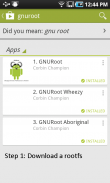
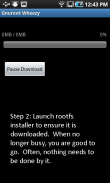
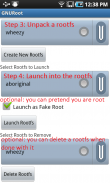
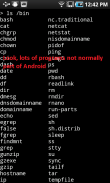
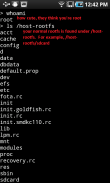
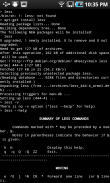
GNURoot

Descrizione di GNURoot
GNURoot provides a method for you to install and use GNU/Linux distributions and their associated applications/packages alongside Android.
This does NOT require root.
A regular uninstall fully cleans up after this application.
This is expandable and you will be able to install your own applciations/packages.
Inside GNURoot, you can create a root file system), launch into it, or delete it.
Read the description of the GNURoot Wheezy, Gentoo, Fedora or Aboriginal apps in the Play Store to get some hints on how to get started using them.
https://play.google.com/store/apps/details?id=champion.gnuroot.wheezy
https://play.google.com/store/apps/details?id=champion.gnuroot.gentoo
https://play.google.com/store/apps/details?id=champion.gnuroot.fedora
https://play.google.com/store/apps/details?id=champion.gnuroot.aboriginal
The moto is: "This ain't done, until everything* will run"
*everything == all linux, user space applications, without having to root your device. Some things (a small number of things), that actually require root will not work (like inserting a kernel module).
Key goals:
Choice or GNU/Linux rootfs to start with:
Currently two choices, many more to come.
All applications that don't absolutely require root should function as normal:
apt-get now working.
Following step is to get a graphical interface for the desktop, terminal and applications. Currently, only launches an Android Terminal Emulator. Proof of concept done. Refinement left.
Make this work nicely alongside Android:
Already works like a "normal" application.
Next step is to provide useful intents for users and applications (with permissions) to use.
Provide proper support and bug fixes:
Release a pay-what-you-want model, so more time can be put into this. Now in place. Decide whether it should be mandatory.
Improve performance:
Minimize the performance effect of the tricks used to make this all work. Quite good now.
Reduce Footprint:
Move as much as possible to the sdcard.
Only install what is necessary and let the user grow it from there.
Support multiple architectures:
Only arm supported. No reason why MIPS and x86 cannot be supported too.
The roots mostly contain GPL code, but for this launcher I am the copyright holder and it is not under the GPL, but instead the Apache v2. It contains a modified version of the Android Terminal Emulator, which is also under the Apache v2.
Please: file bugs, feature requests of view code here:https://github.com/corbinlc/gnurootGNURoot fornisce un metodo per installare e utilizzare distribuzioni GNU / Linux e le loro applicazioni / pacchetti associati a fianco di Android.
Questo non richiede root.
Un disinstallazione regolare pulisce completamente dopo l'applicazione.
Questo è espandibile e sarà in grado di installare i propri applciations / pacchetti.
All'interno GNURoot, è possibile creare un file system di root), lanciarsi in esso, o eliminarlo.
Leggi la descrizione del GNURoot Wheezy, Gentoo, Fedora o applicazioni aborigeni nel Play Store per avere alcuni suggerimenti su come iniziare il loro utilizzo.
https://play.google.com/store/apps/details?id=champion.gnuroot.wheezy
https://play.google.com/store/apps/details?id=champion.gnuroot.gentoo
https://play.google.com/store/apps/details?id=champion.gnuroot.fedora
https://play.google.com/store/apps/details?id=champion.gnuroot.aboriginal
La moto è: "Questo non è fatto, finché tutto * verrà eseguito"
* Tutto == tutti linux, applicazioni spaziali utenti, senza dover sradicare il dispositivo. Alcune cose (un piccolo numero di cose), che in realtà necessitano di root non funziona (come l'inserimento di un modulo del kernel).
Obiettivi principali:
Scelta o GNU / Linux rootfs per cominciare:
Attualmente due scelte, molti altri a venire.
Tutte le applicazioni che non necessitano assolutamente di radice dovrebbero funzionare come normale:
apt-get ora lavora.
Passo successivo è quello di ottenere una interfaccia grafica per il desktop, terminali e applicazioni. Attualmente, lancia solo un emulatore di terminale Android. Proof of concept fatto. Affinamento sinistra.
Fare questo lavoro bene accanto Android:
Già funziona come una applicazione "normale".
Il passo successivo è quello di fornire intenti utili per gli utenti e le applicazioni (con autorizzazioni) da utilizzare.
Fornire supporto e correzioni di bug corretti:
Rilasciare un modello pay-what-you-want, quindi più tempo può essere messo in questo. Ora nel posto. Decidere se dovrebbe essere obbligatorio.
Migliorare le prestazioni:
Ridurre al minimo l'effetto performance dei trucchi usati per fare tutto questo lavoro. Abbastanza bene adesso.
Ridurre l'impronta:
Spostare il più possibile alla sdcard.
Solo installare ciò che è necessario e consentire all'utente di crescere da lì.
Supportare diverse architetture:
Solo braccio supportato. Non c'è ragione per cui MIPS e x86 non possono essere supportati anche.
Le radici contengono la maggior parte del codice GPL, ma per questo lanciatore Io sono il detentore del copyright e non è sotto GPL, ma la v2 Apache. Esso contiene una versione modificata del Android Terminal Emulator, che è anche sotto la Apache v2.
Si prega: bug dei file, richieste di funzionalità di visualizzazione del codice qui:https://github.com/corbinlc/gnuroot



























